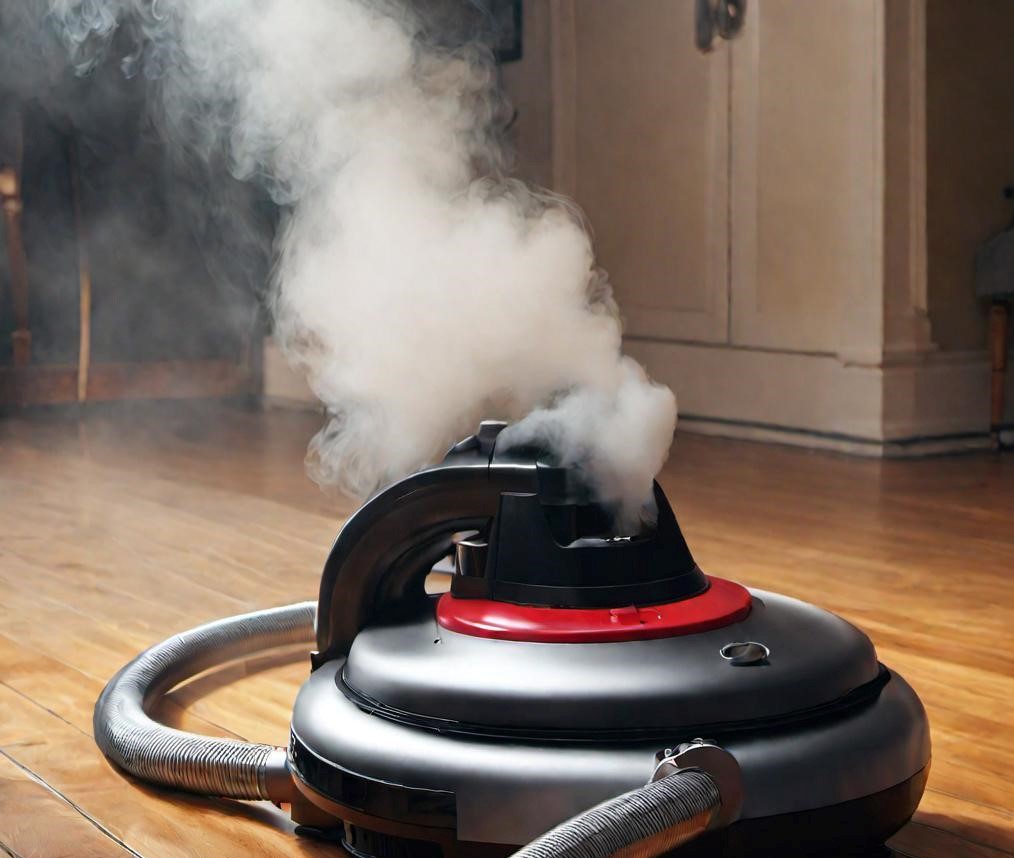Table of contents
Vacuums are household essentials that help us maintain a clean living environment. But what happens when this indispensable tool starts showing signs of distress, like emitting smoke? It can be alarming, to say the least. This article delves into why your vacuum might be smoking and offers solutions to rectify the issue.

1. Overheating Motor
Cause:
The most common reason for a smoking vacuum is an overheated motor. This can be due to prolonged usage, a clogged airway, or a malfunctioning part.
Solution:
- Immediate Action: Turn off the vacuum and unplug it. Let it cool down for at least 30 minutes.
- Long-term: Ensure that the vacuum’s airway is clear and clean. Replace any faulty parts and avoid using the vacuum continuously for extended periods.
2. Blocked Airflow
Cause:
If the vacuum’s filters, hoses, or bags are clogged, it restricts airflow. This can cause the motor to work harder, leading to overheating and smoke.
Solution:
- Check the vacuum bag or canister. If it’s full, empty or replace it.
- Clean or replace clogged filters.
- Inspect hoses for obstructions and remove any blockages.
3. Damaged Belt
Cause:
The vacuum’s belt, which connects the motor to the brush roll, can wear out, misalign, or break. A misaligned or broken belt can create friction, producing smoke.
Solution:
- Turn off and unplug the vacuum.
- Open the vacuum’s underside to inspect the belt.
- If the belt appears damaged or overly worn, replace it.
4. Electrical Issues
Cause:
Faulty wiring, a malfunctioning motor, or a compromised power source can lead to electrical problems, causing the vacuum to emit smoke.
Solution:
- Immediate Action: Disconnect the vacuum from the power source immediately.
- Long-term: Consult a professional or the vacuum manufacturer. It’s essential not to attempt DIY repairs on electrical components if you’re unsure, as this can be dangerous.
5. Foreign Objects
Cause:
Sometimes, vacuums pick up items that they shouldn’t, like wet debris or small toys. These can get stuck and cause friction or blockages, leading to smoke.
Solution:
- Inspect the vacuum for any foreign objects.
- Remove any items that don’t belong, ensuring the vacuum’s pathway is clear.
6. Aged Vacuum
Cause:
Like all appliances, vacuums have a lifespan. An old vacuum may not function as efficiently, and worn-out parts can lead to problems like smoking.
Solution:
- Regular maintenance can extend your vacuum’s life, but there will come a time when it’s best to replace it.
- Consider investing in a new vacuum if yours is significantly old and frequently causing issues.
Tips for Maintaining a Smoke-Free Vacuum
Maintaining a vacuum in optimal condition is paramount not only for effective cleaning but also to prolong the lifespan of the machine. Here’s a detailed insight into how you can achieve this:
1. Regular Emptying and Filter Maintenance
It’s crucial not to wait until your vacuum’s dustbin or bag is overflowing to empty it. Regularly clearing it ensures the motor doesn’t undergo undue stress, leading to potential overheating. In tandem with this, filters play a pivotal role in trapping fine particles and dust. A clogged filter restricts airflow, causing the motor to overwork, which can result in overheating. Therefore, cleaning your filters as per the manufacturer’s recommendation or replacing them when they show evident signs of wear can make a significant difference in your vacuum’s performance.
2. Cord and Vacuum Integrity
The vacuum’s power cord is an often overlooked component. Ensuring it remains untwisted and untangled during its operation guarantees a consistent power supply, which is vital for the machine’s smooth operation. Moreover, like any other appliance, vacuums are susceptible to wear and tear. It’s wise to inspect your vacuum periodically, especially focusing on parts like belts and brushes, and to replace any components that seem worn out to ensure optimal functionality.
3. Vacuuming Habits and Floor Settings
While vacuums are designed to pick up debris, it’s always recommended to manually remove larger or sharp objects from the floor. These can potentially damage the vacuum or lead to blockages, which can strain the motor. Additionally, if your vacuum boasts settings for different floor types, using the appropriate one can prevent putting unnecessary strain on the device. This not only ensures efficient cleaning but also avoids potential damage to both the floor and the vacuum.
4. Proper Storage and Hose Checks
After its operation, storing your vacuum in a cool, dry place can significantly prolong its life. Damp areas can instigate electrical malfunctions, leading to potential smoking or other issues. The hose, being a primary component, should also be regularly checked for any blockages or potential damage. Any compromise in its structure can reduce suction efficiency and overburden the motor.
5. Manufacturer’s Recommendations and Professional Assistance
Always stay in the loop with any updates or recalls from the vacuum’s manufacturer. Occasionally, certain models may be recalled due to unforeseen issues or flaws. Being informed ensures you take timely action if needed. Lastly, while vacuums come with user manuals, not every problem may have a straightforward solution. If ever in doubt, it’s always best to consult the manufacturer or seek professional repair services. A well-maintained vacuum not only serves efficiently but also ensures safety during its operation.
Conclusion
A smoking vacuum can be distressing, but understanding the root cause can guide you towards an effective solution. Regular maintenance and inspections can prevent many of these issues. However, if you’re ever in doubt, especially with potential electrical problems, it’s always best to consult with professionals or the manufacturer. Safety should always be a top priority!
